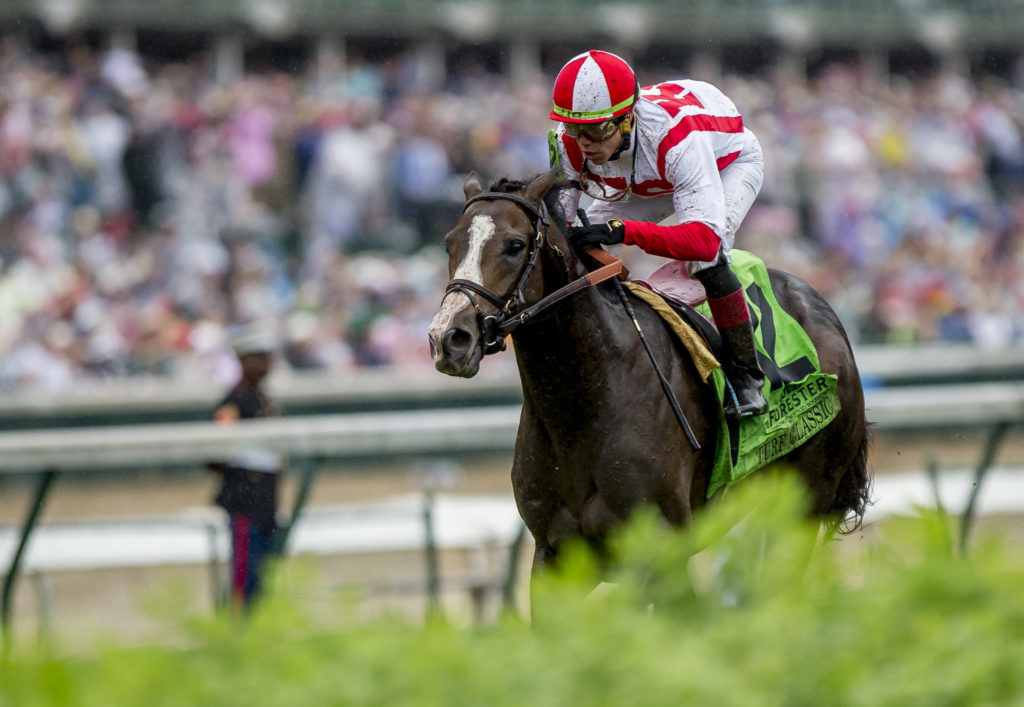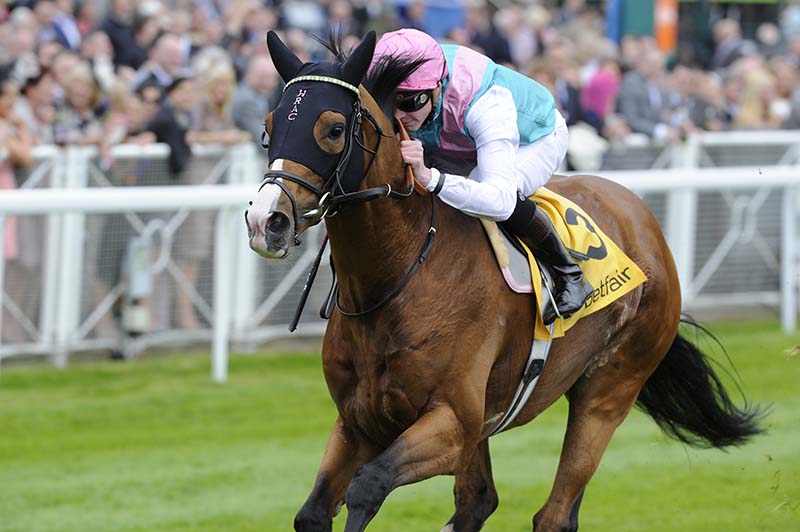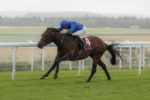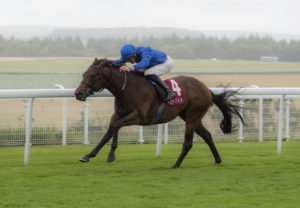Look back to those enviably simple days before the word Brexit cursed the land and you will find that the exchange rate for the US dollar against the pound stood at 1.53 on September 1, 2015.
Four years later the figure had plunged to around 1.20, which suggests strongly that we are going to see much more involvement from American buyers when Book 1 of Tattersalls’ October Yearling Sale gets under way on October 8.
And it isn’t just the exchange rate which will act as an incentive for American owners to invest in yearlings with European turf pedigrees. Although the number of races contested in the US continues to fall (from 74,071 in 1989 to 36,586 in 2018), more races are being run on turf, with 17% per cent of the nation’s races being on turf in 2017, compared to 8.8% as recently as 2004.
It is now not unusual for dirt-bred youngsters to start their careers on the kinder turf courses, with the Kentucky Derby winners Barbaro and Big Brown among them, and this year has seen the predominantly dirt-bred Triple Crown winner American Pharoah make a substantial early splash with his turf two-year-olds. His 12 winners from his first 35 starters included no fewer than eight on turf (including three in Europe).
We are also seeing some valuable additions to America’s turf programme, such as the Pegasus World Cup Turf Invitational Stakes which carried a first prize worth more than £2 million in January 2019. Then there’s the Belmont Derby and Belmont Oaks Invitational Stakes, with these two Grade 1 races having received a considerable boost in their value in 2014.
“They represent a clear incentive for breeders and owners to invest in turf bloodlines”
The success of the Belmont Derby and Oaks has now encouraged the New York Racing Association to instigate a ‘Turf Trinity’ for the colts and geldings and a ‘Turf Tiara’ for the fillies. The Turf Trinity comprises three $1 million races over the same distances as the dirt Triple Crown events.
The second leg, the Saratoga Derby, was contested on August 4, and the series was completed by the Jockey Club Derby over a mile and a half on September 7.
The Turf Tiara comprises three races carrying $750,000 in prize-money, the second leg being the Saratoga Oaks and the third the Jockey Club Oaks.
Although the four new races won’t be eligible for Graded stakes status until their third year, they represent a clear incentive for breeders and owners to invest in turf bloodlines.
The distances of the races also make them ideal for European-bred horses, which generally have stouter pedigrees than their American counterparts.
There is also one more factor which is likely to favour the turf horse. The current public relations nightmare facing America’s racing industry, following the deaths of so many horses at Santa Anita’s winter meeting, is forcing the industry to concentrate on the safety of its racetracks.

Turf hero Bricks And Mortar
Michael Dickinson of Tapeta Footings is advocating a re-think about all-weather surfaces, which were installed, then removed, at several of America’s leading tracks, including Santa Anita, Del Mar and Keeneland.
Dickinson insists that today’s synthetic surfaces are much superior to their predecessors, and the statistics from Wolverhampton and Newcastle suggest strongly that he is right.
“We can’t carry on as we are,” Dickinson recently told the TDN. “The politicians will close us down. We don’t have a choice. I think it’s a choice between safer surfaces or no racing at all. How close were we to having to close down Santa Anita? It’s a different world now than what it was 30 years ago.”
According to the American Jockey Club’s Equine Injury Database, there were 1.68 deaths per 1,000 starters on American racetracks in 2018.
Dirt surfaces had the worst figure, of 1.86 deaths per 1,000 starters, whereas synthetic surfaces were markedly safer at 1.23 per 1,000. But in the argument between traditional dirt and all-weather, it mustn’t be forgotten that the American statistics showed that turf was marginally the safest option, with 1.20 deaths per 1,000 starters.
With racing under ever-increasing scrutiny, it isn’t hard to envisage the number of turf races continuing to climb.
Another factor in favour of European horses is the suspicion that the American thoroughbred has become less sound following decades of raceday medication.
All of which should help maximise American demand for European horses, as should the pleasing North American results achieved by some of the European youngsters which were bought either at the 2016 foal sales or the 2017 yearling sales.
Examples include two daughters of Dansili. Blowout, a €450,000 daughter of the Poule d’Essai des Pouliches winner Beauty Parlour, won the Wild Applause Stakes for Peter Brant and has been placed at Grade 2 and Grade 3 levels, notably failing by only a neck in the Lake Placid Stakes.
Art Of Almost, a Dansili filly who failed to find a buyer at Arqana as a foal, is another who has been placed at Grade 2 and Grade 3 levels.
“American demand for Kingman’s progeny is going to be high at the European yearling sales”
Then there’s Dansili’s son Value Proposition. A 400,000gns purchase from Meon Valley Stud, the colt has carried the colours of Klaravich Stables to victory in two of his three starts.
Another promising sort is Dubawi’s son Demarchelier. Bought for 425,000gns on behalf of Brant, the Newsells Park graduate improved his record to three-for-three when he landed the Pennine Ridge Stakes at Belmont in June. Unfortunately he suffered a condylar fracture to a foreleg when second favourite for the Belmont Derby Invitational Stakes.
The Belmont Derby also featured another colt which was bought as a yearling for Klaravich Stables. This was Digital Age, a 325,000gns son of Invincible Spirit who started third favourite, on the strength of his victory in the American Turf Stakes on the Kentucky Derby undercard.
In finishing fourth in the Belmont Derby, Digital Age suffered his first defeat in four starts, but he was to finish a creditable second in the Saratoga Derby on his next start.
Sadly Chad Brown, the trainer of Digital Age, Demarchelier, Value Proposition and Blowout, has been having a comparatively disappointing time with his Lope de Vega filly Newspaperofrecord.
However, this doesn’t seriously detract from the Klaravich-owned filly’s achievements as a two-year-old, when she beat the future Grade 2 winner Varenka by over six lengths in the Miss Grillo Stakes and then took the Breeders’ Cup Juvenile Fillies Turf by nearly seven.
The Brown-Brant combination also paid 400,000gns for Sketches Of Spain, a 2017 Lope de Vega filly who made a winning debut at Saratoga, with the help of the stewards.
I suspect that American demand for Kingman’s progeny is also going to be high at the European yearling sales this autumn. Klaravich paid only 120,000gns for his son out of the Cherry Hinton Stakes winner Please Sing, but the colt – now named Good Governance – made a belated winning debut at Saratoga on August 4.
Good Governance was then odds-on for the Saranac Stakes towards the end of the Saratoga meeting and failed by only a neck to land the $110,000 first prize.
Saratoga also saw Kingman’s daughter Jazzique come from a long way back to take a spring maiden on her debut for Chad Brown.

Noble Mission was a three time top-level performer in three countries – Photo: George Selwyn
Noble Mission setting a fine example
It will also be interesting to see whether breeders in America are becoming more willing to use European-bred turf stallions.
They weren’t particularly keen when the Juddmonte-bred Powerscourt retired to Ashford Stud after a career which twice saw him cross the line first in the Arlington Million (on the second occasion winning by three lengths from Kitten’s Joy).
After four seasons, during which his fee went from $12,500 to $7,500, Powerscourt was sold to Turkey. He received only 39 mares in his final season.
Perhaps breeders could be forgiven their indifference, as they weren’t aware that Frankel, a colt bred to a similar pattern to Powerscourt, was going to develop into a superstar in Europe over the next few years. Powerscourt was sired by Frankel’s grandsire Sadler’s Wells from Frankel’s second dam Rainbow Lake.
Powerscourt currently ranks as the broodmare sire of America’s outstanding turf filly Concrete Rose. This daughter of the up-and-coming Twirling Candy easily added the Saratoga Oaks Invitational to her earlier victory over raiders from Ireland, Japan and France in the Belmont Oaks Invitational.
There has also been major success for Frankel’s American-based brother Noble Mission with his three-year-olds from his first crop sired at Lane’s End. Of course Noble Mission was a turf specialist who became a Group 1 winner in three countries, most notably when following in Frankel’s footsteps in the QIPCO Champion Stakes.
Mated to the dirt specialist Reunited, a winner of five of her eight three-year-old starts including a Grade 3, Noble Mission is responsible for one of America’s top dirt three-year-olds in Code Of Honor. Foaled as late as May 23, Code Of Honor turned in a career-best effort when he landed the Travers Stakes on August 24, supplemented – with the help of the stewards – by victory in the Grade 1 Jockey Club Gold Cup on September 28.
When mated to Limonar, a mile Listed winner on turf in France, Noble Mission sired Spanish Mission, a decisive winner of the Bahrain Trophy. Coincidentally, Spanish Mission’s owners decided to miss the St Leger in favour of the newly-instituted Jockey Club Derby at Belmont, in which they were rewarded when he ran down Pedro Caro to win the $1 million event.



